Provenance: Remembrance of Small Things Past
“A tama, a heart-stone, a tiny and very old Greek donkey blanket (upon which all these redolent objects rest): these are the things I took away with me over 63 years, to amuse, remind, enrich, and define me. On a little gate-backed walnut table (also a gift from Aunt Willie Sue), is the small exoskeleton I carry going forward, and looking back; the bare bones on which memory rests, like a gossamer shawl.”—By Elizabeth Boleman-Herring
By Way of Being
By Elizabeth Boleman-Herring
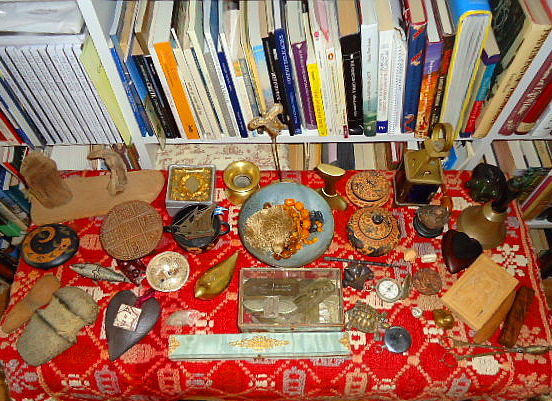
“Behind all seen things lies something vaster; everything is but a path, a portal or a window opening on something other than itself.”―Antoine de Saint-Exupéry, from Wind, Sand and Stars
Author’s Note, 15 September 2022: This column was written between a first cousin’s ancestry.com testing, back when that testing was first offered, and my own, very recently, via 23&me. My first cousin does, indeed, have a half-Cherokee mother and a Cherokee grandparent, but I do not, family lore notwithstanding. Just recently, I found that I am about as Northwestern-European as a body can be, with a tiny dollop of Neanderthal.
PETIT TRIANON Florida—(Weekly Hubris)—8/17/2015—Wherever I have hung my hat in adulthood, my personal space has been . . . riddled with altars.
Not altars erected to “received deities” but, rather, collections of totems, assemblies of memory-stones, strings of beads to “tell,” and re-tell. Objets trouvés. Also, objects given as tokens of affection, declarations of love. Objects embodying received wisdom.
I attribute this obsession of mine to create assemblages primarily to the nomadic nature of my existence, the decades and decades I have spent on the road, pitching tents hither and yon across the planet. (It’s no wonder I also collect kilims and small Navajo rugs: textiles may be rolled, folded, and easily packed but, in their glorious pattern and texture, whisper a story of riches beheld and remembered.)
In essence, wherever I call home becomes more a spirit house, in the Thai sense, than a permanent dwelling. Most of the things I surround myself with are ritual objects, down to my mother’s wooden spoons, still used to stir sauces, but carved in Monastiraki, Athens, Greece’s central market, in the early 1960s, and reminders of my long-lost parents, and all the meals they cooked together happily over 36 years of marriage.
Most of my husband’s possessions are easily parsed, veritably broadcasting their identities. The 12,000 LPs, the 8,000 CDs, the trumpets, the drum set, the sheet music: to even an untrained eye, their nature and significance is knowable.
My own objects are unknown knowns. Unknowable to anyone who does not share my entire history. Runes in a church of one. A bit like the tiny antiquities on Freud’s desk in the Freud House Museum. (As Freud remarked, explaining to a patient that conscious material “wears away” while what is unconscious is relatively unchanging, “I illustrated my remarks by pointing to the antique objects about my room. They were, in fact, I said, only objects found in a tomb, and their burial had been their preservation.”)
These things littering Dean’s and my shared space now, arranged in little groupings like terrestrial constellations, are mine (all mine), their meanings masked. The only key to them is in my head and, if I don’t disperse and distribute them, and tell their small stories before consciousness departs my cranium, they will be tossed to the winds without history, without voice, without provenance.
There is nothing inherently “valuable” on the little gate-legged table behind our sofa, but all the pieces are significant to me.
There are some 50 objects, though some of these are containers (bowls, small boxes, copies of ancient Greek reliquaries), and they embrace other groups of objects.
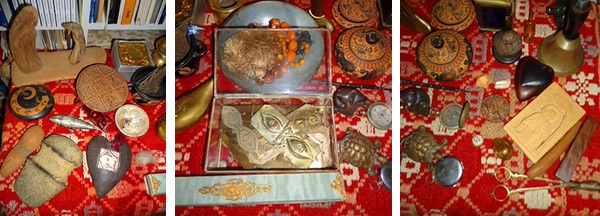
Among the oldest things here are two Upcountry, South Carolina tomahawks or battle hammers, one edge of each sharpened and the other featuring a groove so that the stone might be tied to a handle with rawhide. The larger weapon came down to me via my maternal aunt, Willie Sue, half-Cherokee, from my full-blooded Cherokee grandfather, Lon Schenault Boleman. Cherokee culture in the foothills of the Blue Ridge Mountains stretches back 11,000 years, and so these two humble objects tie me to the long trajectory of my mother’s people: they are heavy in every way possible, and beautifully made, though I shudder, knowing they have been rinsed of blood again and again and again.
Another pair of objects—stones collected from the seabed off the islet of Angistri, in Greece—bear the patterns of long-dissolved sea creatures, undatable except by a geologist steeped in Aegean paleontology. I remember, now, the joy I experienced upon diving down, with snorkel and mask, to retrieve them.
Here, too, is the first object I ever coveted, and was given, when I was five: a clear quartz crystal bought from a roadside stand in California as my parents and I set out for a camping trip.
There are two pocket compasses; the older, my father’s vintage Ceebynite (here beside a steel cylinder he used to keep matches dry on family camping trips into the wilds of Canada). Both objects, I believe, date from his time in the Eagle Scouts or, later, with the Florida Coast Guard.
There is a brass bell always kept by the bed of any sick child in my maternal grandmother’s house in Townville, South Carolina. My mother, the youngest surviving child in the family, remembered the bell well: she had rung it last when felled by diphtheria, which she survived at home in the 1920s, long before the advent of universal vaccination.
Also from Townville is my Great Aunt Alice Smith’s brass inkwell, and a tiny string of very, very old crystal, blue-glass, and amber beads, threaded on a crude piece of twine. I found them in the very bottom of Papa Boleman’s wooden traveling trunk, and I suspect they date from early “Indian times” in Reed Creek, Georgia. Their provenance will always be a mystery, but they are all I have left from a stretch of unknowable-now history. Who kept these seemingly worthless beads on this piece of brown twine? Why? All I know now is that my grandparents treasured them, for some reason, and placed them at the very bottom of a trunk that held Civil War buttons, family correspondence dating from the 19th century, and Aunt Alice’s Blue-Backed speller.
There are Greek worry-beads here, nesting in my mother’s favorite blue bowl, which she called her “Kabloona bowl,” as it is the same color as an early edition of Gontran de Poncins’s book.
A copy of a covered Corinthian bowl, the original dating from 650 B.C., and a gift to my mother one Christmas, holds strands of my mother’s hair, a tiny sand dollar I fished out of the sea off Galaxidi, and fabric hearts I sent home one Christmas when I had not a drachma to my name to buy richer gifts for her.
Many other small objects were either holiday presents for my mother, mailed to her in Atlanta and Clemson from wherever I was living in Greece, or gifts to me, from Greek students and colleagues. Most come from Monastiraki antique shops and the Benaki Museum. One box—another classical copy—holds a ceramic scarab my father bought from a peddler in Egypt’s Valley of the Kings. It was 1961, and peddlers were still hawking ancient grave goods. The scarab’s a poor copy, but beads my father bought for pennies there were the real thing. Alas.
My mother collected antique fans, and one lies here in a long, narrow handmade box covered in turquoise taffeta and embellished with gold filigree. One of her fans is a fragile ivory masterpiece, which I have framed. This one is made of sandalwood, painted and lacquered. The box itself was lovingly made, marked in pencil on the bottom “FExx.” I am sure she once told me its origins, but I have forgotten. Now, it is just another of the beautiful, nameless orphans bequeathed me by my family.
One of my father’s carved driftwood sculptures is here, a desert father and a burning bush. On the beach at Ventura, in the 1950s, he would collect wood; then cut and carve small sculptures. This is the finest that survives.
I also have, on this table, a ceramic head made by one of my father’s adolescent psychiatric patients. Unsigned, grotesque, glazed-black and ominous, it might just as well have been made by Picasso. Beside it is another clay piece by another young patient: a child, imprisoned in a cage, with a coiled snake. My father never brought their stories home, but I have kept the evidence of their suffering, and release through art.
There is more. A donkey’s tooth from St. John’s Beach on Mykonos. The coccyx of a Cycladic goat. A carved wooden icon of St. George a friend brought back to me from Mount Athos. A tiny alabaster decanter from Cairo, containing the kohl my mother once put into her eyes. An Arts & Crafts mechanical pencil shaped like a twig.
A glass box of tamata, or Greek votive offerings, meant to be attached to icons in Greek Orthodox churches: tangible proof of and thanks for prayers answered.
Again, my peripatetic life and my lifelong poverty drew me to tamata. When I began collecting the old ones—most, made of tin—no one in Greece was interested in them and they were relegated to the bottoms of dusty drawers in Flea Market shops. Thus, I have many 19th-century images of husbands and wives in Victorian dress, staring eyes, children in short pants holding Easter candles or massive crosses; even a horse. But, mostly, eyes. Blindness, among the hardscrabble, hardworking poor of 19th– and early-20th-century Greece would have been the ultimate threat. And so, all these small tin images of gratitude for sight restored and preserved.
. . . and hundreds of heart-shaped stones I have collected on Greek beaches, especially Santorini, whose littorals seem strewn with them by some great prehistoric carver.
A tama, a heart-stone, a tiny and very old Greek donkey blanket (upon which all these redolent objects rest): these are the things I took away with me over 63 years, to amuse, remind, enrich and define me.
On a little gate-backed walnut table (also a gift from Aunt Willie Sue), is the small exoskeleton I carry going forward, and looking back; the bare bones on which memory rests, like a gossamer shawl.
To order Elizabeth Boleman-Herring’s memoir and/or her erotic novel, click on the book covers below:
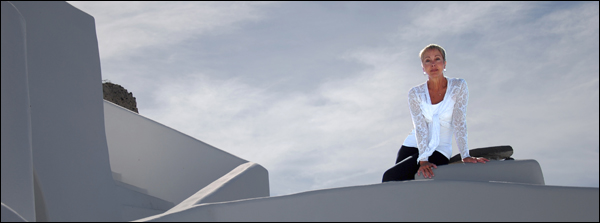

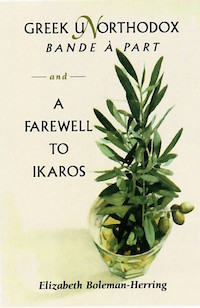
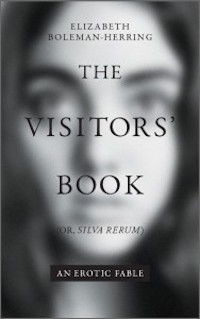
6 Comments
Anita Sullivan
It’s so good to hear your voice again here at Weekly Hubris. What a beautiful array of tiny stories, I’m going to go right back and read them all again. What a fine lesson in exo-skeleton building. Thank you so much!
Elizabeth Boleman-Herring
Anita, thank you. You know central Florida has snuffed me, as even New Jersey failed to do. Marjorie Kennan Rawlings, I am not. :-) But thank you for reading. This was an intensely private piece, perhaps too precious for a “magazine.” I so wish I were better at Petrarchan sonnets, My Beloved Friend. Now, it’s your turn. I miss your voice, always.
Diana
Wish I were with you to go over these treasures one by one and hear their stories and what they mean to you. Some types of these memory traps we share, especially the stones, bits of antiquities, sand dollars and prehistoric tools, be they flint or obsidian. But most of all I was cheered to see my books sitting in your collection. As I have yours, some of them anyway, at home in mine. And Anita says, good to have you back.
Elizabeth Boleman-Herring
Thank you, Diana. And yes, those are some verrry special books behind the table! Someone asked me today where I would prefer living, and I answered without a beat: “Athens, Greece. 1985.”
Laura
So interesing, Elizabeth :)
Elizabeth Boleman-Herring
Thank you, Laura. We hope to see you and Bubba “up” this way, and down that way, soon!